AFB has made employment a priority area, and it’s easy to see why. People with vision loss often face significant barriers to employment, and the woefully low employment rate for people who are blind or visually impaired hasn’t budged in the last decade, hovering around 35% compared to 70% for people without disabilities.
But it doesn’t have to be this way. AFB is taking a multipronged approach to improve the workplace participation rate for people who are blind or visually impaired. One vital aspect of this approach was AFB’s designation as a Central Nonprofit Agency (CNA) under the AbilityOne Program, one of the country’s largest sources of employment for people who are blind or have significant disabilities.
As a CNA, AFB will partner with nonprofits, government agencies, and corporations to identify innovative ways to maximize one of the benefits of the Javits-Wagner-O’Day Act, which requires federal agencies to purchase specified supplies and services from nonprofit agencies that employ people who are blind or have significant disabilities.
What’s more, AFB wants to expand the potential of AbilityOne to create new career-development opportunities for people with visual impairments in the fast-growing industries of financial services, healthcare, and information technology. Ultimately, the goal is to create pathways to competitive, integrated employment in the public and private sectors.
“We know that through their lived experience, people who are blind are problem solvers, team builders, and great communicators—the same talents and skills 21st-century employers are looking for,” explains Kirk Adams, president and CEO of AFB. “We want to create a model where people with vision loss who have talent, drive, and ambition can gain work experience at a nonprofit agency and develop the skills necessary to move into corporate America.”
Research has already shown that once employers hire people with visual impairments, those employers are inclined to hire more, because they quickly recognize the workers’ contributions. But many employers first need to learn about the relatively simple infrastructure and technology accommodations needed for people who are blind to perform successfully in the workplace.
“Once we prove this concept and have some significant numbers of people who are blind in workplaces, momentum will take care of itself,” Adams says. “Employers will understand what a wonderful opportunity they have to move their organization forward by being inclusive and bringing this talent into their workplace.”
